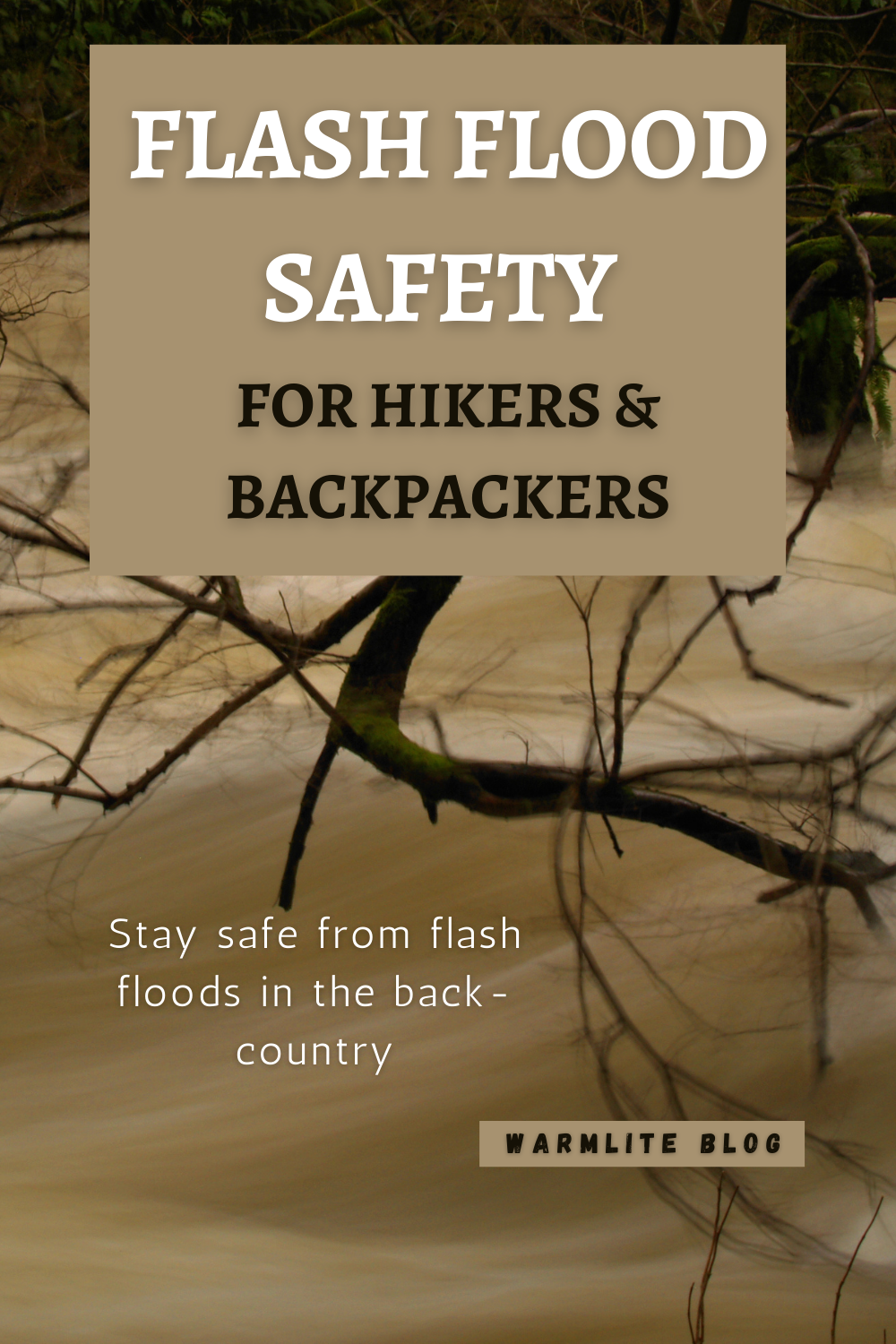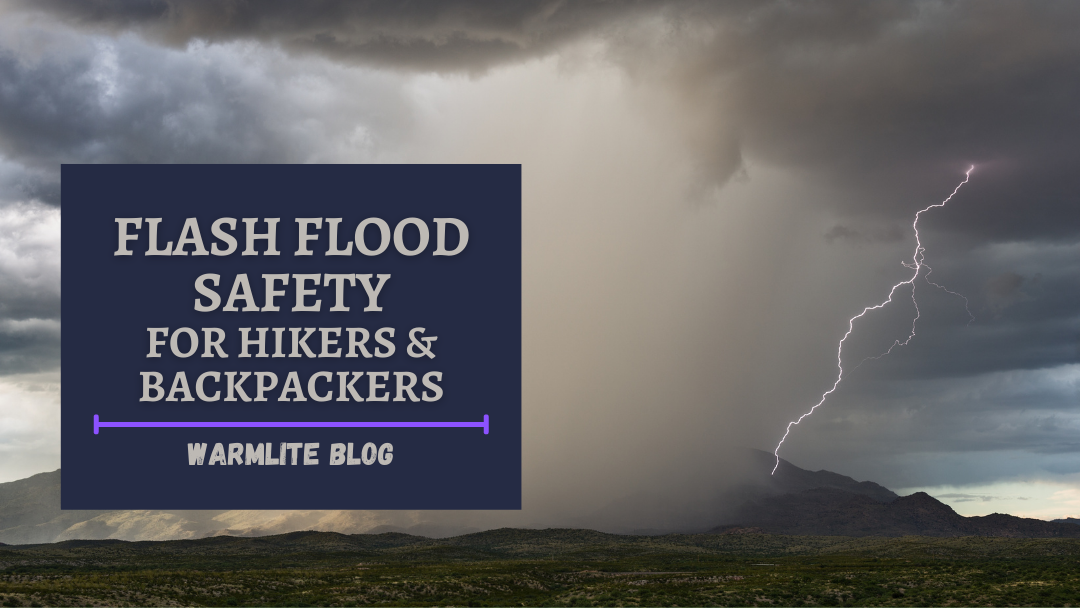Flash Flood Safety for Hikers and Backpackers
By Jessica Marie
In last weeks’ blog post we covered lightning and thunderstorm safety for outdoor activities. Another important element of outdoor safety that comes from rain and thunderstorms is flooding. Flash flooding poses an extreme threat to hikers, backpackers, kayakers, hunters, fishermen, and outdoor explorers at all times of year and any time of day. Flash flooding kills more people every year than any other extreme weather event (CDC & NWS). Let’s get into flash flood safety for hikers and backpackers.
Plan Ahead
Before you leave consider these as reasons to forego a trip to an area.
- Unusually hard rain over several hours
- Steady, substantial rain over several days
- Rains in conjunction with a spring thaw
- A monsoon or other tropical system affecting your area
- Weather alerts
These are all wonderful conditions for flash flooding. If these conditions exist, it may be best to postpone a trip to that area until a later date. You can always contact your local weather station or park service on the safety, dangers, risks, or closures of an area before you head out.
In accordance with the last item on that list, let’s define the various terms used by the NWS/NOAA on Flash Flood alert definitions.
Flash Flood WATCH
Issued when conditions look favorable for flash flooding. A WATCH usually encompasses several counties. This is the time to start thinking about your plan of action and where you would go if water begins to rise.
Flash Flood WARNING
Issued when dangerous flash flooding is happening or will happen soon. A WARNING is usually a smaller, more specific area. This can be issued due to excessive heavy rain or a dam/levee failure. This is when you must act quickly as flash floods are an imminent threat to you and your family. You may only have seconds to move to higher ground.
Flash Flood EMERGENCY
Issued for the EXCEEDINGLY RARE situations when extremely heavy rain is leading to a severe threat to human life and CATASTROPHIC DAMAGE from a flash flood is happening or will happen soon. Typically, emergency officials are reporting LIFE THREATENING water rises resulting in water rescues/evacuations.
Check the Weather
First and foremost, before heading out on any outdoor excursion be sure to check the weather. Not only for the immediate area you will be traveling to, but the surrounding areas as well. Lightning can travel 10 miles from a storm system, and flash floods can affect areas up to 100 miles away. Knowing the weather can help you pack accordingly as well as keep you alert for weather events that can take place near you. This is not foolproof as weather can change, but every bit of preparedness can help you explore more safely.
Know Your Route
An important element of flash flood safety for hikers is knowing the elevation and topography of where you are going. Will you be up high or will you be in canyons? Being up high may help protect you from flash flooding but can pose a higher risk of lightning strikes. Knowing your topography also allows you to know the best ways and places to escape from various types of danger.
Flash flooding can occur due to dam or levee breaks. Knowing if you are near, upstream, or downstream of such landmarks is very important to know.
Know if you are walking upstream or downstream. This informs you from which direction flooding would come.
Pay Attention to Your Surroundings
The lower you go the higher the likelihood that you may be in a flood zone. Canyons, gullies, rivers, streams, dry riverbeds, runoff zones, ravines, caves, etc. They may appear safe one moment, but they can fill with water quickly. Flash flooding can affect downstream and lower elevation areas up to 100 miles away from a storm system. At that distance you will likely not see or hear the storm that drops the water heading your way.
- If you are on a dry riverbed that begins to fill with water, evacuate immediately. Head for higher ground, then head to your vehicle.
- If a stream or river begins to change from clear to muddy or cloudy, evacuate immediately. Head for higher ground, then head to your vehicle.
- Listen to your surroundings. This is important for many reasons. It can alert you to an injured hiker, wildlife threats, thunder, flash floods, and more. Never hike while using earbuds or headphones as you can miss the auditory cues of danger or needed help. If you hear loud roaring evacuate immediately. This may be the only warning you have of a wall of water heading your way. Climb to higher ground immediately.
River Safety
We are drawn to water and often spend time in and around bodies of water. The point of this blog post isn’t to scare you away from enjoying the great outdoors, it is simply to keep you aware of dangers and give you the know-how to safely enjoy nature. Here are some general river safety tips.
- Do not make camp near rivers, streams, or water shed areas. These can fill with water in the night and catch you while you are sleeping.
- 6 inches of flowing water can sweep a person off their feet and carry them downstream.
- Water can fill a river, ravine, or canyon in seconds, minutes, or slowly over the course of an hour or so. We can never be sure which option will be presented. This is why it is best to immediately leave when conditions change or become less than ideal. It is better to be safe than sorry.
- Be extra careful at night as flooding can be much harder to see.
When hiking to cross a stream, follow these steps:
- Wait for everyone in the party to arrive at the stream, then make a determination if to cross.
- Do not walk through a flowing stream on foot where water is above your ankles.
- When walking on rocks or logs over a stream, loosen pack buckles so if you fall you can easily get away from your pack and it will not drag you under.
- Wait for everyone to cross before continuing (in case the last person needs assistance).
When Leaving the Area
If you are caught in a thunderstorm with flash floods, read this article on lightning safety. Once you get to your vehicle, safely and carefully leave the area. Do not drive through flood waters. Water 12-24 inches in depth can carry away all vehicles. Cars, SUV’s, vans, Jeep’s, trucks, can all be carried away by two feet or less of water. If you cannot be sure of the depth of the water, do not take the chance. Stay put and wait for the flooding to subside or for emergency services.
After flooding has subsided the flood waters could have damaged bridges and roadways making them unsafe to cross. If you are unsure of the safety or integrity of the road, do not cross.
If you become trapped, inform friends/family of your location as well as Search and Rescue or local park rangers as they may have advice for where you can best evacuate to. If you cannot contact outside assistance, this is where your having notified your friends/family of your destination and route before you left will be very helpful. If you are unable to return by the specified time, they can notify authorities and send assistance to you.
Other Information
Many GPS devices for hikers and outdoor enthusiasts have built in NOAA weather alert systems. They can help alert you to nearby weather events and keep you up to date.
Stay out of flood waters as they can carry dangers beyond rushing water. Dangers such as animals, insects, downed power lines, sewage, chemicals, debris like trees and boulders, and more.
Conclusion
Being outdoors is something we associate with good times, good memories, and new places to explore. There are also inherent risks with being outside and exposed to nature. Nature is beautiful and powerful. We must respect that we are heading out into the wilderness away from certain safety assurances. The further outdoors one goes the more responsibility one must take for oneself and their safety. Enjoy this summer, enjoy the beautiful and incredible outdoors. But also stay safe. Don’t take undue risks, turn back at the first signs of change or danger, you can always come back a different day. These are our tips for flash flood safety for hikers, backpackers and outdoor adventurers.
Resources (Used/referenced/helpful in this blog post):
https://www.weather.gov/mob/Severe_Flood
https://www.cdc.gov/nceh/toolkits/floods/default.html
http://www.usscouts.org/usscouts/safety/flash-floods.asp
https://www.weather.gov/media/bis/Floods.pdf



Recent Comments